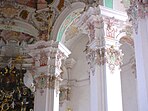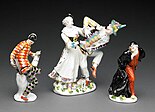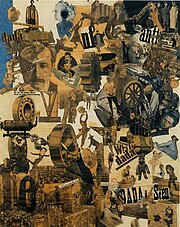German art

German arthas a long and distinguished tradition in thevisual arts,from the earliest known work of figurative art to its current output ofcontemporary art.
Germany has only been united into a single state since the 19th century, and defining its borders has been a notoriously difficult and painful process. For earlier periods German art often effectively includes that produced in German-speaking regions includingAustria,Alsaceand much ofSwitzerland,as well aslargely German-speaking cities or regions to the eastof the modern German borders.
Although tending to be neglected relative to Italian and French contributions from the point of view of theEnglish-speaking world,German art has played a crucial role in the development ofWestern art,especiallyCeltic art,Carolingian artandOttonian art.From the development ofRomanesque art,France and Italy began to lead developments for the rest of theMiddle Ages,but the production of an increasingly wealthy Germany remained highly important.
TheGerman Renaissancedeveloped in rather different directions to theItalian Renaissance,and was initially dominated by the central figure ofAlbrecht Dürerand the early German domination of printing. The final phase of the Renaissance,Northern Mannerism,was centred around the edges of the German lands, inFlandersand the Imperial capital ofPrague,but, especially in architecture, the GermanBaroqueandRococotook up these imported styles with enthusiasm. The German origins ofRomanticismdid not lead to an equally central position in the visual arts, but German participation in the many broadlyModernistmovements following the collapse ofAcademic arthas been increasing important.
Prehistory to Late Antiquity
[edit]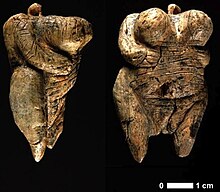
The area of modernGermanyis rich in finds ofprehistoric art,including theVenus of Hohle Fels,found in theSwabian Alps.This appears to be the oldest undisputed example ofUpper Paleolithic artandfigurativesculpture of the human form in general, from over 42,000 years BP, which was only discovered in 2008;[1][2][3]the better-knownVenus of Willendorf(24–22,000 BP) comes from a little way over the Austrian border. The spectacular finds ofBronze Agegolden hatsare centred on Germany, as was the "central" form ofUrnfield culture,andHallstatt culture.

In theIron Agethe "Celtic"La Tène culturecentred on Western Germany and Eastern France, and Germany has produced many major finds ofCeltic artlike the elite burials atReinheimandHochdorf,andoppidatowns likeGlauberg,ManchingandHeuneburg.[citation needed]
After lengthy wars, theRoman Empiresettled its frontiers inGermaniawith theLimes Germanicusto include much of the south and west of modern Germany. The German provinces produced art in provincial versions of Roman styles, but centres there, as over the Rhine in France, were large-scale producers of fineAncient Roman pottery,exported all over the Empire.[citation needed]Rheinzabernwas one of the largest, which has been well-excavated and has a dedicated museum.[4]
Non-Romanized areas of the later Roman period fall underMigration Period art,notable for metalwork, especially jewellery (the largest pieces apparently mainly worn by men).[citation needed]
Middle Ages
[edit]Carolingian art
[edit]
German medieval art really begins with theFrankish EmpireofCharlemagne(d. 814), the first state to rule the great majority of the modern territory of Germany, as well as France and much of Italy.Carolingian artwas restricted to a relatively small number of objects produced for a circle around the court and a number ofImperial abbeysthey sponsored, but had a huge influence on laterMedieval artacross Europe. The most common type of object to survive is theilluminated manuscript;wall paintings were evidently common but, like the buildings that housed them, have nearly all vanished. The earlier centres of illumination were located in modern France, but laterMetzinLorraineand theAbbey of Saint Gallin modernSwitzerlandcame to rival them. TheDrogo SacramentaryandFolchard Psalterare among the manuscripts they produced.[5]
No Carolingianmonumental sculpturesurvives, although perhaps the most important patronage of Charlemagne was his commissioning of a life-size gold figure ofChriston acrucifixfor hisPalatine Chapel in Aachen;this is only known from literary references and was probably gold foil around a wooden base, probably modelled with agessolayer, like the later and rather crumpledGolden Madonna of Essen.Early Christian arthad not featured monumental sculptures of religious figures as opposed to rulers, as these were strongly associated by theChurch Fatherswith the cult idols ofAncient Roman religion.Byzantine artand modernEastern Orthodoxreligious art have maintained the prohibition to the present day, but Western art was apparently decisively influenced by the example of Charlemagne to abandon it. Charlemagne's circle wished to revive the glories of classical style, which they mostly knew in itsLate Antiqueform, and also to compete withByzantine art,in which they appear to have been helped by refugee artists from the convulsions of theByzantine iconoclasm.As Charlemagne himself does not appear to have been very interested in visual art, his political rivalry with theByzantine Empire,supported by thePapacy,may have contributed to the strong pro-image position expressed in theLibri Carolini,which set out the position on images held with little variation by the Western Church for the rest of theMiddle Ages,and beyond.[6]
Ottonian art
[edit]
Under the nextOttonian dynasty,whose core territory approximated more closely to modern Germany, Austria, and German-speaking Switzerland,Ottonian artwas mainly a product of the large monasteries, especiallyReichenauwhich was the leading Western artistic centre in the second half of the 10th century. The Reichenau style uses simplified and patterned shapes to create strongly expressive images, far from the classical aspirations of Carolingian art, and looking forward to the Romanesque. The woodenGero Crossof 965–970 inCologne Cathedralis both the oldest and the finest early medieval near life-size crucifix figure; art historians had been reluctant to credit the records giving its date until they were confirmed bydendrochronologyin 1976.[7]As in the rest of Europe, metalwork was still the most prestigious form of art, in works like the jewelledCross of Lothair,made about 1000, probably inCologne.[citation needed]
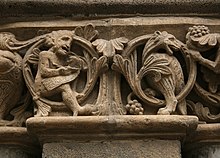
Romanesque art
[edit]Romanesque artwas the first artistic movement to encompass the whole ofWestern Europe,though with regional varieties. Germany was a central part of the movement, thoughGerman Romanesque architecturemade rather less use of sculpture than that of France. With increasing prosperity massive churches were built in cities all over Germany, no longer just those patronized by the Imperial circle.[8]
Gothic art
[edit]The French invented theGothic style,and Germany was slow to adopt it, but once it had done so Germans made it their own, and continued to use it long after the rest of Europe had abandoned it. According toHenri Focillon,Gothic allowed German art "to define for the first time certain aspects of its native genius-a vigorous and emphatic conception of life and form, in which theatrical ostentation mingled with vehement emotional frankness."[9]TheBamberg Horsemanof the 1330s, inBamberg Cathedral,is the oldest large post-antique standing stone equestrian statue; more medieval princelytomb monumentshave survived from Germany than France or England. Romanesque and Early Gothic churches had wall paintings in local versions of international styles, of which few artists' names are known.[10]

The court of theHoly Roman Emperor,then based inPrague,played an important part in forming theInternational Gothicstyle in the late 14th century.[11]The style was spread around the wealthy cities of Northern Germany by artists suchConrad von SoestinWestphalia,Meister BertraminHamburg,and laterStefan LochnerinCologne.Hamburg was one of the cities in theHanseatic League,when the League was at height of its prosperity. Bertram was succeeded in the city by artists such asMaster Francke,theMaster of the Malchin Altar,Hans Bornemann,Hinrik FunhofandWilm Dedekewho survived into the Renaissance period. Hanseatic artists painted commissions for Baltic cities inScandinaviaand the modernBaltic statesto the east. In the south, theMaster of the Bamberg Altaris the first significant painter based inNuremberg,while theMaster of Heiligenkreuzand thenMichael Pacherworked in Austria.[citation needed]
Like that of Pacher, the workshop ofBernt Notke,a painter from the Hanseatic city ofLübeck,both paintedaltarpiecesor carved them in the increasingly elaborate painted and gilded style used as frameworks or alternatives for painted panels. South German wood sculpture was important in developing new subjects that reflected the intensely emotional devotional life encouraged by movements in late medieval Catholicism such asGerman mysticism.These are often known in English asandachtsbilder(devotional images) and include thePietà,Pensive Christ,Man of Sorrows,Arma Christi,Veil of Veronica,the severed head ofJohn the Baptist,and theVirgin of Sorrows,many of which would spread across Europe and remain popular until the Baroque and, in popular religious imagery, beyond. Indeed "Late Gothic Baroque" is a term sometimes used to describe hyper-decorated and emotional 15th-century art, above all in Germany.[12]
Martin Schongauer,who worked in Alsace in the last part of the 15th century, was the culmination of late Gothic German painting, with a sophisticated and harmonious style, but he increasingly spent his time producing engravings, for which national and international channels of distribution had developed, so that hisprintswere known in Italy and other countries. His predecessors were theMaster of the Playing CardsandMaster E. S.,both also from the Upper Rhine region.[13]German conservatism is shown in the late use of gold backgrounds, still used by many artists well into the 15th century.[14]
Renaissance painting and prints
[edit]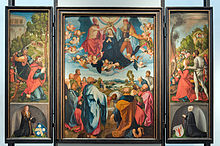
The concept of theNorthern RenaissanceorGerman Renaissanceis somewhat confused by the continuation of the use of elaborate Gothic ornament until well into the 16th century, even in works that are undoubtedly Renaissance in their treatment of the human figure and other respects. Classical ornament had little historical resonance in much of Germany, but in other respects Germany was very quick to follow developments, especially in adoptingprintingwithmovable type,a German invention that remained almost a German monopoly for some decades, and wasfirst brought to most of Europe,including France and Italy, by Germans.[citation needed]
Printmaking and Dürer
[edit]
Printmakingbywoodcut,etching,invented byDaniel Hopfer,andengraving(perhaps another German invention) was already more developed in Germany and theLow Countriesthan anywhere else, and the Germans took the lead in developing book illustrations, typically of a relatively low artistic standard, but seen all over Europe, with the woodblocks often being lent to printers of editions in other cities or languages. The greatest artist of the German Renaissance,Albrecht Dürer,began his career as an apprentice to a leading workshop in Nuremberg, that ofMichael Wolgemut,who had largely abandoned his painting to exploit the new medium. Dürer worked on the most extravagantly illustrated book of the period, theNuremberg Chronicle,published by his godfatherAnton Koberger,Europe's largest printer-publisher at the time.[15]
After completing his apprenticeship in 1490, Dürer travelled in Germany for four years, and Italy for a few months, before establishing his own workshop in Nuremberg. He rapidly became famous all over Europe for his energetic and balanced woodcuts and engravings, while also painting. Though retaining a distinctively German style, his work shows strong Italian influence, and is often taken to represent the start of the German Renaissance in visual art, which for the next forty years replaced the Netherlands and France as the area producing the greatest innovation in Northern European art. Dürer supportedMartin Lutherbut continued to createMadonnasand other Catholic imagery, and paint portraits of leaders on both sides of the emerging split of theProtestant Reformation.[15]
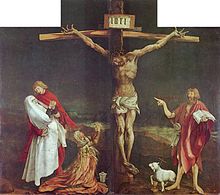
Dürer died in 1528, before it was clear that the split of the Reformation had become permanent, but his pupils of the following generation were unable to avoid taking sides. Most leading German artists became Protestants, but this deprived them of painting most religious works, previously the mainstay of artists' revenue.Martin Lutherhad objected to much Catholic imagery, but not to imagery itself, andLucas Cranach the Elder,a close friend of Luther, had painted a number of "Lutheran altarpieces", mostly showing theLast Supper,some with portraits of the leading Protestant divines as theTwelve Apostles.This phase of Lutheran art was over before 1550, probably under the more fiercelyaniconicinfluence ofCalvinism,and religious works for public display virtually ceased to be produced in Protestant areas. Presumably largely because of this, the development of German art had virtually ceased by about 1550, but in the preceding decades German artists had been very fertile in developing alternative subjects to replace the gap in their order books.Lucas Cranach the Younger,apart from portraits, developed a format of thin vertical portraits of provocative nudes, given classical or Biblical titles.[16]
Lying somewhat outside these developments isMatthias Grünewald,who left very few works, but whose masterpiece, hisIsenheim Altarpiece(completed 1515), has been widely regarded as the greatest German Renaissance painting since it was restored to critical attention in the 19th century. It is an intensely emotional work that continues the German Gothic tradition of unrestrained gesture and expression, using Renaissance compositional principles, but all in that most Gothic of forms, the multi-wingedtriptych.[17]
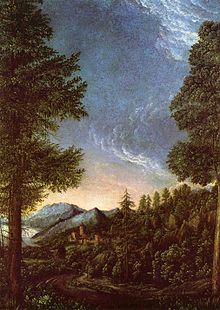
Danube School and Northern Mannerism
[edit]TheDanube Schoolis the name of a circle of artists of the first third of the 16th century inBavariaand Austria, includingAlbrecht Altdorfer,Wolf HuberandAugustin Hirschvogel.With Altdorfer in the lead, the school produced the first examples of independentlandscape artin the West (nearly 1,000 years after China), in both paintings and prints.[18]Their religious paintings had anexpressioniststyle somewhat similar to Grünewald's. Dürer's pupilsHans BurgkmairandHans Baldung Grienworked largely in prints, with Baldung developing the topical subject matter ofwitchesin a number of enigmatic prints.[19]
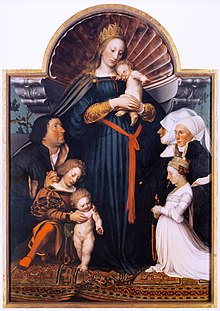
Hans Holbein the Elderand his brother Sigismund Holbein painted religious works in the late Gothic style. Hans the Elder was a pioneer and leader in the transformation of German art from the Gothic to the Renaissance style. His son,Hans Holbein the Youngerwas an important painter of portraits and a few religious works, working mainly in England and Switzerland. Holbein's well known series of small woodcuts on theDance of Deathrelate to the works of theLittle Masters,a group of printmakers who specialized in very small and highly detailed engravings for bourgeois collectors, including many erotic subjects.[21]
The outstanding achievements of the first half of the 16th century were followed by several decades with a remarkable absence of noteworthy German art, other than accomplished portraits that never rival the achievement of Holbein or Dürer. The next significant German artists worked in the rather artificial style ofNorthern Mannerism,which they had to learn in Italy or Flanders.Hans von Aachenand the NetherlandishBartholomeus Sprangerwere the leading painters at the Imperial courts inViennaand Prague, and the productive NetherlandishSadeler familyof engravers spread out across Germany, among other counties.[22]This style was continued for another generation byBartholomeus Strobel,an example of an essentially German artist born and working inSilesia,in today'sPoland,until he emigrated to escape theThirty Years Warand become painter at the Polish court.Adam Elsheimer,the most influential German artist in the 17th century, spent his whole mature career in Italy, where he began by working for another émigréHans Rottenhammer.Both produced highly finishedcabinet paintings,mostly on copper, with classical themes and landscape backgrounds.[citation needed]
Gothic and Renaissance sculpture
[edit]In Catholic parts of South Germany the Gothic tradition of wood carving continued to flourish until the end of the 18th century, adapting to changes in style through the centuries.Veit Stoss(d. 1533),Tilman Riemenschneider(d.1531) andPeter Vischer the Elder(d. 1529) were Dürer's contemporaries, and their long careers covered the transition between the Gothic and Renaissance periods, although their ornament often remained Gothic even after their compositions began to reflect Renaissance principles.[23]
Two and a half centuries later,Johann Joseph ChristianandIgnaz Güntherwere leading masters in the late Baroque period, both dying in the late 1770s, barely a decade before theFrench Revolution.A vital element in the effect of German Baroque interiors was the work of theWessobrunner School,a later term for thestuccoistsof the late 17th and 18th centuries. Another manifestation of German sculptural skill was inporcelain;the most famous modeller isJohann Joachim Kaendlerof theMeissenfactory in Dresden, but the best work ofFranz Anton Bustellifor theNymphenburg Porcelain ManufactoryinMunichis often considered the greatest achievement of 18th-century porcelain.[24]
17th to 19th-century painting
[edit]Baroque, Rococo and Neoclassicism
[edit]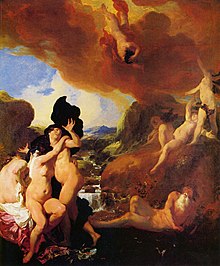

Baroque paintingwas slow to arrive in Germany, with very little before about 1650, but once established seems to have suited German taste well.BaroqueandRococoperiods saw German art producing mostly works derivative of developments elsewhere, though numbers of skilled artists in various genres were active. The period remains little-known outside Germany, and though it "never made any claim to be among the great schools of painting", its neglect by non-German art history remains striking.[25]Many distinguished foreign painters spent periods working in Germany for princes, among themBernardo BellottoinDresdenand elsewhere, andGianbattista Tiepolo,who spent three years painting theWürzburg Residencewithhis son.Many German painters worked abroad, includingJohann Lisswho worked mainly inVenice,Joachim von SandrartandLudolf Bakhuisen,the leading marine artist of the final years ofDutch Golden Age painting.In the late 18th century the portraitistHeinrich Fügerand his pupilJohann Peter Krafft,whose best known works are three large murals in theHofburg,had both moved to Vienna as students and stayed there.[26]
Neoclassicism,which was born largely thanks to the writings ofJohann Joachim Winckelmann,appears rather earlier in Germany than in France, withAnton Raphael Mengs(1728–79), the Danish painterAsmus Jacob Carstens(1754–98), and the sculptorGottfried Schadow(1764–1850). Mengs was one of the most highly regarded artists of his day, working in Rome, Madrid and elsewhere, and finding an earlyNeo-Classicalstyle that now seems rather effete, although his portraits are more effective. Carstens' shorter career was turbulent and troubled, leaving a trail of unfinished works, but through pupils and friends such asGottlieb Schick,Joseph Anton KochandBonaventura Genelli,more influential.[27]Koch was born in the mountains of the AustrianTyroland became the leading Continental painter oflandscapes,concentrating on mountain views, despite spending much of his career in Rome.[citation needed]
Daniel Chodowieckiwas born inDanzig,and at least partly identified as Polish, although he only spoke German and French. His paintings and hundreds of prints, book illustrations and political cartoons are an invaluable visual record of the everyday life and the increasingly complex mentality ofEnlightenmentGermany, and its emergingNationalism.[28]The Swiss-bornAnton Graffwas a prolific portraitist in Dresden, who painted literary figures as well as the court. TheTischbein familydynasty were solid all-rounders who covered most of the 18th century between them, as did theZickfamily, initially mainly painters of grand Baroque ceilings, who were still active in the 20th century in the person of the illustratorAlexander Zick.[29]Both theAsam brothers,andJohann Baptist Zimmermannandhis brother,were able between them to provide a complete service for commissions for churches and palaces, designing the building and executing the stucco and wall-paintings. The combined effect of all the elements of these buildings in South Germany, Austria andBohemia,especially their interiors, represent some of the most complete and extreme realizations of the Baroque aspiration to overwhelm the viewer with the "radiant fairy world of the nobleman's dwelling", or the "foretaste of the glories of Paradise" in the case of churches.[30]
The earliest Germanacademywas theAkademie der Künstefounded inBerlinin 1696, and through the next two centuries a number of other cities established their own institutions, in parallel with developments in other European nations. In Germany the uncertain market for art in a country divided into a multitude of small states meant that significant German artists have been to the present day more likely to accept teaching posts in the academies and their successor institutions than their equivalents in England or France have been. In general German academies imposed a particular style less rigidly than was for long the case in Paris, London, Moscow or elsewhere.[citation needed]
Writing about art
[edit]
The Enlightenment period saw German writers becoming leading theorists and critics of art, led byJohann Joachim Winckelmann,who exaltedAncient Greek artand, despite never visiting Greece or actually seeing many Ancient Greek statues, set out an analysis distinguishing between the main periods of Ancient Greek art, and relating them to wider historical movements. Winckelmann's work marked the entry of art history into the high-philosophical discourse of German culture; he was read avidly byGoetheandFriedrich Schiller,both of whom began to write on the history of art, and his account of theLaocoön Groupoccasioned a response byLessing.Goethe had tried to train as an artist, and his landscape sketches show "occasional flashes of emotion in the presence of nature which are quite isolated in the period".[31]
The emergence of art as a major subject of philosophical speculation was solidified by the appearance ofImmanuel Kant'sCritique of Judgmentin 1790, and was furthered byHegel'sLectures on Aesthetics.In the following century, German universities were the first to teach art history as an academic subject, beginning the leading position that Germany (and Austria) was to occupy in the study ofart historyuntil the dispersal of scholars abroad in the Nazi period.Johann Gottfried Herderchampioned what he identified in the Gothic and Dürer as specifically Germanic styles, beginning an argument over the proper models for a German artist against the so-called "Tyranny of Greece over Germany" that would last nearly two centuries.[32]
Romanticism and the Nazarenes
[edit]
German Romanticismsaw a revival of innovation and distinctiveness in German art. Outside Germany onlyCaspar David Friedrichis well-known, but there were a number of artists with very individual styles, notablyPhilipp Otto Runge,who like Friedrich had trained at theCopenhagen Academyand was forgotten after his death until a revival in the 20th century. Friedrich painted almost entirely landscapes, with a distinctive Northern feel, and always a feeling of quasi-religious stillness. Often his figures are seen from behind – they like the viewer are lost in contemplation of the landscape.[33]Runge's portraits, mostly of his own circle, are naturalistic except for his huge-faced children, but the other works in his brief career increasingly reflected a visionarypantheism.[34]Adrian Ludwig Richteris mainly remembered for his portraits, andCarl Wilhelm Kolbewas purely anetcher(as well as aphilologist), whose later prints show figures almost swallowed up by gigantic vegetation.[35]

TheNazarene movement,the coinage of a mocking critic, denotes a group of early 19th-century German Romantic painters who aimed to revive honesty and spirituality in Christian art. The principal motivation of the Nazarenes was a reaction against Neoclassicism and the routine art education of the academy system. They hoped to return to art which embodied spiritual values, and sought inspiration in artists of the late Middle Ages and early Renaissance, rejecting what they saw as the superficial virtuosity of later art. Their programme was not dissimilar to that of the EnglishPre-Raphaelite Brotherhoodin the 1850s, although the core group took it as far as wearing special pseudo-medieval clothing. In 1810Johann Friedrich Overbeck,Franz Pforr,Ludwig Vogeland the Swiss Johann Konrad Hottinger moved toRome,where they occupied the abandoned monastery of San Isidoro. They were joined byPhilipp Veit,Peter von Cornelius,Julius Schnorr von Carolsfeld,Friedrich Wilhelm Schadowand a loose grouping of other German artists. They met up with the Austrian romantic landscape artist Joseph Anton Koch, (1768–1839) who became an unofficial tutor to the group. In 1827 they were joined byJoseph von Führich,andEberhard Wächterwas later associated with the group. Unlike the strong support given to the Pre-Raphaelites by the dominant art critic of the day,John Ruskin,Goethe was dismissive of the Nazarenes: "This is the first case in the history of art when real talents have taken the fancy to form themselves backwards by retreating into their mother's womb, and thus found a new epoch in art."[36]
Led by the Nazarene Schadow, son of the sculptor, theDüsseldorf schoolwas a group of artists who painted mostly landscapes, and who studied at, or were influenced by theDüsseldorf Academy,founded in 1767. The academy's influence grew in the 1830s and 1840s, and it had many American students, several of whom became associated with theHudson River School.[37]
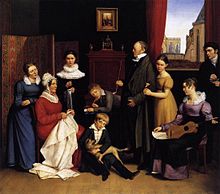
Naturalism and beyond
[edit]Biedermeierrefers to a style in literature, music, the visual arts and interior design in the period between the end of theNapoleonic Warsin 1815 and the revolutions of 1848. Biedermeier art appealed to the prosperous middle classes by detailed but polishedrealism,often celebrating domestic virtues, and came to dominate over French-leaning aristocratic tastes, as well as the yearnings of Romanticism.Carl Spitzwegwas a leading German artist in the style.[38]TheZimmerbildor "portrait" of an empty room, became a popular form.
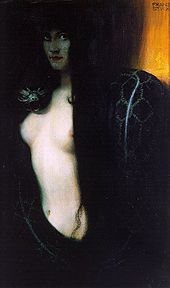
In the second half of the 19th century a number of styles developed, paralleling trends in other European counties, though the lack of a dominant capital city probably contributed to even more diversity of styles than in other countries.[39]
Adolph Menzelenjoyed enormous popularity both among the German public and officialdom; at his funeralWilhelm II, German Emperorwalked behind his coffin. He dramaticised past and contemporaryPrussianmilitary successes both in paintings and brilliantwood engravingsillustrating books, yet his domestic subjects are intimate and touching. He followed the development of earlyImpressionismto create a style that he used for depicting grand public occasions, among other subjects like hisStudio Wall.Karl von Pilotywas a leadingacademicpainter of history subjects in the latter part of the century who taughtin Munich;among his more famous pupils wereHans Makart,Franz von Lenbach,Franz Defregger,Gabriel von MaxandEduard von Grützner.The term "Munich school" is used both of Germanand of Greek painting,after Greeks likeGeorgios Jakobidesstudied under him.[citation needed]Piloty's most influential pupil was Wilhelm Leibl. Being the head of the so called Leibl-Circle, an informal group of artists with a non-academic approach to art, he had a great impact on Realism in Germany.[40]

TheBerlin Secessionwas a group founded in 1898 by painters includingMax Liebermann,who broadly shared the artistic approach ofManetand the FrenchImpressionists,andLovis Corinththen still painting in a naturalistic style. The group survived until the 1930s, despite splits, and its regular exhibitions helped launch the next two generations of Berlin artists, without imposing a particular style.[41]Near the end of the century, theBenedictineBeuron Art Schooldeveloped a style, mostly for religious murals, in rather muted colours, with amedievalistinterest in pattern that drew fromLes Nabisand in some ways looked forward toArt Nouveauor theJugendstil( "Youth Style" ) as it is known in German.[42]Franz von StuckandMax Klingerare the leading GermanSymbolistpainters.[citation needed]
20th century
[edit]Expressionism and the Bauhaus
[edit]
Even more than in other countries, German art in the early 20th century developed through a number of loose groups and movements, many covering other artistic media as well, and often with a specific political element, as with theArbeitsrat für KunstandNovember Group,both formed in 1918. In 1922 The November Group, the Dresden Secession, Das Junge Rheinland, and several other progressive groups formed a "Cartel of advanced artistic groups in Germany" (Kartell fortschrittlicher Künstlergruppen in Deutschland) in an effort to gain exposure.[43]
Die Brücke( "The Bridge" ) was one of two groups of German painters fundamental toexpressionism,the other beingDer Blaue Reitergroup. Die Brücke was a group of German expressionist artists formed inDresdenin 1905 by architecture students who wanted to be painters:Fritz Bleyl(1880–1966),Erich Heckel(1883–1970),Ernst Ludwig Kirchner(1880–1938) andKarl Schmidt-Rottluff(1884–1976), withMax Pechsteinand others later joining.[44]The notoriously individualisticEmil Nolde(1867–1956) was briefly a member of Die Brücke, but was at odds with the younger members of the group. Die Brücke moved to Berlin in 1911, where it eventually dissolved in 1913. Perhaps their most important contribution had been the rediscovery of thewoodcutas a valid medium for original artistic expression.[citation needed]
Der Blaue Reiter( "The Blue Rider" ) formed inMunich,Germany in 1911.Wassily Kandinsky,Franz Marc,August Macke,Alexej von Jawlensky,Marianne von Werefkinand others founded the group in response to the rejection of Kandinsky's painting Last Judgment from an exhibition by Neue Künstlervereinigung—another artists' group of which Kandinsky had been a member. The name Der Blaue Reiter derived from Marc's enthusiasm for horses, and from Kandinsky's love of the colour blue. For Kandinsky, blue is the colour of spirituality—the darker the blue, the more it awakens human desire for the eternal (see his 1911 book On the Spiritual in Art). Kandinsky had also titled a painting Der Blaue Reiter (see illustration) in 1903.[45]The intense sculpture and printmaking ofKäthe Kollwitzwas strongly influenced byExpressionism,which also formed the starting point for the young artists who went on to join other tendencies within the movements of the early 20th century.[46]
Die BrückeandDer Blaue Reiterwere both examples of tendency of early 20th-century German art to be "honest, direct, and spiritually engaged"[47]The difference in how the two groups attempted this were telling, however. The artists of Der Blaue Reiter were less oriented towards intense expression of emotion and more towards theory- a tendency which would lead Kandinsky to pure abstraction. Still, it was the spiritual and symbolic properties of abstract form that were important. There were therefore Utopian tones to Kandinsky's abstractions: "We have before us an age of conscious creation, and this new spirit in painting is going hand in hand with thoughts toward an epoch of greater spirituality."[48]Die Brückealso had Utopian tendencies, but took the medieval craft guild as a model of cooperative work that could better society- "Everyone who with directness and authenticity conveys that which drives him to creation belongs to us".[49]TheBauhausalso shared these Utopian leanings, seeking to combine fine and applied arts (Gesamtkunstwerk) with a view towards creating a better society.[citation needed]
Weimar period; Dada and beyond
[edit]A major feature of German art in the early 20th century until 1933 was a boom in the production of works of art of agrotesquestyle.[50][51]Artists using theSatirical-Grotesquegenre includedGeorge Grosz,Otto DixandMax Beckmann,at least in their works of the 1920s.Dadain Germany, the leading practitioners of which wereKurt SchwittersandHannah Höch,was centered in Berlin, where it tended to be more politically oriented than Dada groups elsewhere.[52]They made important contributions to the development of collage as a medium for political commentary- Schwitters later developed hisMerzbau,a forerunner of installation art.[52]Dix and Grosz were also associated with the Berlin Dada group.Max Ernstled aDadagroup in Cologne, where he also practiced collage, but with a greater interest in Gothic fantasy than in overt political content—this hastened his transition intosurrealism,of which he became the leading German practitioner.[53]The Swiss-bornPaul Klee,Lyonel Feiningerand others experimented withcubism.[citation needed]
TheNew Objectivity,or Neue Sachlichkeit (new matter-of-factness), was an art movement which arose in Germany during the 1920s as an outgrowth of, and in opposition to, expressionism. It is thus post-expressionist and applied to works of visual art as well as literature, music, and architecture. It describes the stripped-down, simplified building style of theBauhausand theWeissenhof Settlement,the urban planning and public housing projects ofBruno TautandErnst May,and the industrialization of the household typified by theFrankfurt kitchen.Grosz and Dix were leading figures, forming the "Verist" side of the movement with Beckmann andChristian Schad,Rudolf Schlichter,Georg Scholz(in his early work),Elfriede Lohse-Wächtler,andKarl Hubbuch.The other tendency is sometimes calledMagic Realism,and includedAnton Räderscheidt,Georg Schrimpf,Alexander Kanoldt,andCarl Grossberg.Unlike some of the other groupings, the Neue Sachlichkeit was never a formal group, and its artists were associated with other groups; the term was invented by a sympathetic curator, and "Magic Realism" by an art critic.[54]
Plakatstil,"poster style" in German, was an early style ofposterdesign that began in the early 20th century, using bold, straight fonts with very simple designs, in contrast toArt Nouveauposters.Lucian Bernhardwas a leading figure.[citation needed]
Art in the Third Reich
[edit]The Nazi regime bannedmodern art,which they condemned asdegenerate art(from the German: entartete Kunst). According to Nazi ideology, modern art deviated from the prescribed norm ofclassical beauty.While the 1920s to 1940s are considered the heyday of modern art movements, there were conflicting nationalistic movements that resented abstract art, and Germany was no exception. Avant-garde German artists were now branded both enemies of the state and a threat to the German nation. Many went into exile, with relatively few returning after World War II. Dix was one who remained, being conscripted into theVolkssturmHome Guard militia; Pechstein kept his head down in ruralPomerania.Nolde also stayed, creating his "unpainted pictures" in secret after being forbidden to paint. Beckmann, Ernst, Grosz, Feininger and others went to America, Klee to Switzerland, where he died. Kirchner committed suicide.[55]
In July, 1937, the Nazis mounted a polemical exhibition entitledEntartete Kunst(Degenerate art), in Munich; it subsequently travelled to eleven other cities in Germany and Austria. The show was intended as an official condemnation of modern art, and included over 650 paintings, sculptures, prints, and books from the collections of thirty two German museums. Expressionism, which had its origins in Germany, had the largest proportion of paintings represented. Simultaneously, and with much pageantry, the Nazis presented theGrosse deutsche Kunstausstellung(Great German art exhibition) at the palatialHaus der deutschen Kunst(House of German Art). This exhibition displayed the work of officially approved artists such asArno BrekerandAdolf Wissel.At the end of four monthsEntartete Kunsthad attracted over two million visitors, nearly three and a half times the number that visited the nearbyGrosse deutsche Kunstausstellung.[56]
Post-World War II art
[edit]Neo-expressionism, Richter and Socialist realism
[edit]

Post-war art trends in Germany can broadly be divided intoSocialist realismin the DDR (communistEast Germany), and inWest Germanya variety of largely international movements includingNeo-expressionismandConceptualism.[citation needed]

Notable socialist realism include or includedWalter Womacka,Willi Sitte,Werner TübkeandBernhard Heisig.

Especially notable neo-expressionists include or includedGeorg Baselitz,Anselm Kiefer,Jörg Immendorff,A. R. Penck,Markus Lüpertz,Peter Robert KeilandRainer Fetting.Other notable artists who work with traditional media or figurative imagery includeMartin Kippenberger,Gerhard Richter,Sigmar Polke,andNeo Rauch.[citation needed]
Leading German conceptual artists include or includedBernd and Hilla Becher,Hanne Darboven,Hans-Peter Feldmann,Hans Haacke,andCharlotte Posenenske.[57]
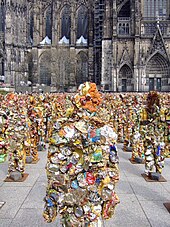
Performance art, happenings, video art and Joseph Beuys
[edit]ThePerformance artist,sculptor, and theoristJoseph Beuyswas perhaps the most influential German artist of the late 20th century.[58]His main contribution to theory was the expansion of theGesamtkunstwerkto include the whole of society, as expressed by his famous expression "Everyone is an artist". This expanded concept of art, known associal sculpture,defines everything that contributes creatively to society as artistic in nature. The form this took in his oeuvre varied from richly metaphoric, almost shamanistic performances based on his personal mythology (How to Explain Pictures to a Dead Hare,I Like America and America Likes Me) to more direct and utilitarian expressions, such as7000 Oaksand his activities in theGreen party.[citation needed]
Famous for their happenings areHA Schultand Wolf Vostell.Wolf Vostellis also known for his early installations with television. His first installations with television theCycle Black Roomfrom 1958 was shown inWuppertalat the Galerie Parnass in 1963 and his installation6 TV Dé-coll/agewas shown at the Smolin Gallery[59]in New York also in 1963.[60][61]
The art groupGruppe SPURincluded:Lothar Fischer(1933–2004),Heimrad Prem(1934–1978),Hans-Peter Zimmer(1936–1992) andHelmut Sturm(1932). The SPUR-artists met first at the Academy of Fine Arts, Munich and, before falling out with them, were associated with theSituationist International.Other groups include theJunge Wildeof the late 1970s to early 1980s.[citation needed]
documenta(sic) is a major exhibition of contemporary art held inKasselevery five years (2007, 2012...),Art Cologneis an annual art fair, again mostly for contemporary art, andTransmedialeis an annual festival for art and digital culture, held in Berlin.[citation needed]
Other contemporary German artists includeJonathan Meese,Daniel Richter,Albert Oehlen,Markus Oehlen,Rosemarie Trockel,Andreas Gursky,Thomas Ruff,Blinky Palermo,Hans-Jürgen Schlieker,Günther Uecker,Aris Kalaizis,Katharina Fritsch,Fritz SchweglerandThomas Schütte.[citation needed]
Notes
[edit]- ^Venus figurine sheds light on origins of art by early humansLos Angeles Times,May 14, 2009, accessed December 11, 2009
- ^"Archäologie erleben - Mission Eiszeit | SWR Geschichte & Entdeckungen".YouTube.Archivedfrom the original on 2023-12-16.Retrieved2023-12-16.
- ^""It must be a woman" - The female depictions from Hohle Fels date to 40,000 years ago... "Universität Tübingen. July 22, 2016. Archived fromthe originalon October 11, 2016.RetrievedJuly 26,2016.
- ^Terra Sigillata Museum Rheinzabern(in German)
- ^See Hinks throughout, Chapters 1 of Beckwith and 3–4 of Dodwell
- ^Dodwell, 32 on theLibri Carolini
- ^Beckwith, Chapter 2
- ^Beckwith, Chapter 3
- ^Focillon, 106
- ^Dodwell, Chapter 7
- ^Levey, 24-7, 37 & passim, Snyder, Chapter II
- ^Snyder, 308
- ^Snyder, Chapters IV (painters to 1425), VII (painters to 1500), XIV (printmakers), & XV (sculpture).
- ^Focillon, 178–181
- ^abBartrum (2002)
- ^Snyder, Part III, Ch. XIX on Cranach, Luther etc.
- ^Snyder, Ch. XVII
- ^Wood, 9 – this is the main subject of the whole book
- ^Snyder, Ch. XVII, Bartrum, 1995
- ^"BBC - Dark arts: Holbein and the court of Henry VIII".BBC.Retrieved2021-12-30.
- ^Snyder, Ch. XX on the Holbeins, Bartrum (1995), 221–237 on Holbein's prints, 99–129 on the Little Masters
- ^Trevor-Roper, Levey
- ^Snyder, 298–311
- ^Savage, 156
- ^Griffiths & Carey, 24 (quotation), and Scheyer, 9 (from 1960, but the point remains valid)
- ^Novotny, 62–65
- ^Novotny, 49–59
- ^Griffiths & Carey, 50–68, Novotny, 60–62
- ^Novotny, 60
- ^Gombrich, 352–357; quotes from pp. 355 & 357
- ^Novotny, 78 (quotation); and see index for Winckelmann etc.
- ^The rhetorical phrase was coined, or popularized, by:Butler, Eliza M.,"The Tyranny of Greece over Germany: a study of the influence exercised by Greek art and poetry over the great German writers of the eighteenth, nineteenth, and twentieth centuries" (Cambridge Univ. Press, London, 1935)
- ^Novotny, 95–101
- ^Novotny, 106–112
- ^Griffiths and Carey, 112–122
- ^Griffiths & Carey, 24–25 andpassim,quotation from p. 24
- ^John K. Howat: American Paradise: The World of the Hudson River School, S. 311
- ^Doyle, Margaret, inEncyclopedia of the Romantic Era, 1760–1850, Volume 1, ed. Christopher John Murray, p. 89, Taylor & Francis, 2004ISBN1-57958-361-X,Google books
- ^Hamilton, 180
- ^Wilhelm Leibl. The art of seeing, Kunsthaus Zürich, 2019
- ^Hamilton, 181–184, and see index for later mentions
- ^Hamilton, 113
- ^Crockett, Dennis (1999).German Post-Expressionism: The Art of the Great Disorder 1918–1924.University Park, Pa: Pennsylvania State University Press. p. 76.ISBN0271043164.
- ^Hamilton, 197–204, and Honour & Fleming, 569–576
- ^Honour & Fleming, 569–576, and Hamilton, 215–221
- ^Hamilton, 189–191
- ^Hunter, Jacobus, and Wheeler (2000) p. 113
- ^qtd. Hunter et al p. 118
- ^From the Manifesto of Die Brücke, qtd Hunter et al p. 113
- ^Esti Sheinberg(2000)Irony, Satire, Parody and the Grotesque in the Music of Dmitrii Shostakovich,pp.248–9,ISBN978-0-7546-0226-2
- ^Pamela Kort(2004)Comic Grotesque,Prestel PublishingISBN978-3-7913-3195-9
- ^abHunter, Jacobus, and Wheeler (2000) pp. 173–77
- ^Hamilton, 473–478
- ^Hamilton, 478–479
- ^"Ernst Ludwig Kirchner Biography, Art, and Analysis of Works".Retrieved2015-09-29.
- ^Hamilton, 486–487
- ^Marzona, Daniel. (2005)Conceptual Art.Cologne: Taschen. Various pages
- ^Moma Focus,retrieved 16 December 2009
- ^Rolf Wedewer. Wolf Vostell. Retrospektive, 1992,ISBN3-925520-44-9
- ^Wolf Vostell,Cycle Black Room,1958, installation with television
- ^Wolf Vostell,6 TV Dé-coll/age,1963, installation with television
References
[edit]| Part ofa serieson the |
| Culture of Germany |
|---|
 |
| Festivals |
| Music |
Further reading
[edit]- German masters of the nineteenth century: paintings and drawings from the Federal Republic of Germany.New York: The Metropolitan Museum of Art. 1981.ISBN978-0-87099-263-6.
- Nancy Marmer, "Isms on the Rhine: Westkunst,"Art in America,Vol. 69, November 1981, pp. 112–123.

